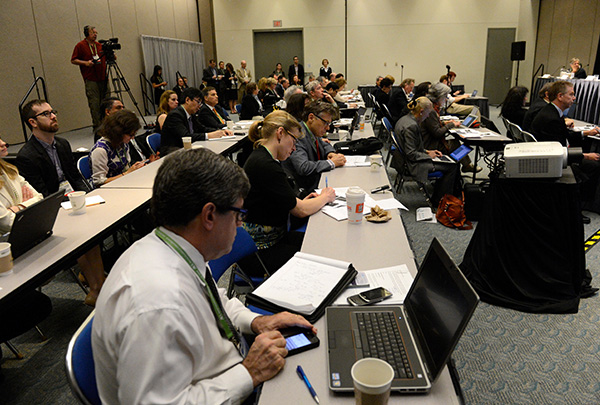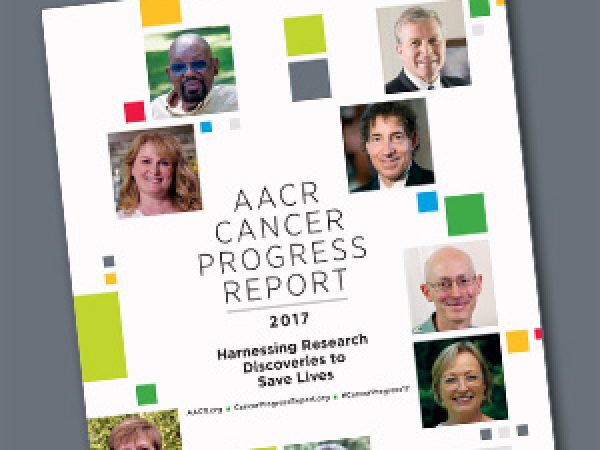Behind the Scenes: Getting the Word Out About the AACR Annual Meeting
Cancer Research Catalyst’s Behind the Scenes series provides an inside look at the planning and development of the AACR’s Annual Meeting, a must-attend event for cancer researchers. Read other posts in the series.
With the start of the AACR Annual Meeting 2015 only four days away, the organization is ramping up its communications and public relations efforts to bring attention to the excellent science and new discoveries for patients that will be presented during the meeting in Philadelphia, April 18-22.
The core of the AACR’s media outreach efforts is the official AACR Annual Meeting press program. As soon as abstracts are accepted, they are reviewed by a team of communications professionals and cancer researchers in the Communications and Public Relations Department for scientific strength and impact as well as newsworthiness. Final selections for the press program are made with input from the Annual Meeting program chair, program committee, and AACR leadership.
“We strive to compile the best and most representative press program possible, with a good mix of basic science, clinical trials, epidemiology studies, and prevention research,” says Rick Buck, senior director of communications and public relations for the AACR. “The Annual Meeting gives us a lot of incredibly strong presentations to choose from. There is so much great science. It can be tough to narrow it down.”

The scene during a press conference at the AACR Annual Meeting 2014 in San Diego. The AACR will host three press conferences highlighting noteworthy research this year.
Once the press program is finalized, the Communications and Public Relations Department begins reaching out to the authors featured in the press program to confirm their participation and draft news releases based on their research. The department also begins reaching out to reporters to build interest in the meeting.
“We usually have well over 100 reporters and producers covering the meeting,” says Buck. “While it’s a must-attend event for many of them, we’re always trying to expand our reach. Our team spends a lot of time building relationships with journalists.”
At the meeting, the Communications and Public Relations team manages the press room, which serves as a home base for reporters. In addition, they host daily press conferences with selections from the press program. This year, the press conferences will take place Sunday, Monday, and Tuesday during the meeting.
Collaborating with cancer centers and their media relations staff is an important part of successfully promoting the Annual Meeting. To this end, the Communications and Public Relations team engages cancer center PR staff before and during the meeting. “Our cancer center colleagues have the same goal we do. We all want to raise awareness about the important work being done by cancer researchers, who are our members and their institutions’ established scientists and early-career investigators,” Buck says. “We really enjoy working with them.”
In addition to traditional media outreach, the Communications and Public Relations Department maintains the AACR’s robust social media presence during the Annual Meeting on Facebook, Twitter, and LinkedIn. Through these channels, the AACR provides updates on events, lectures, and sessions, as well practical information about the meeting. Two members of Buck’s team also plan a Professional Advancement Session on social media for cancer researchers.
As a department that regularly collaborates with nearly all other departments in the organization, the Communications and Public Relations team has a variety of other major responsibilities during the Annual Meeting, from managing the webcasts to keeping the website updated to filming interviews with leaders in cancer research and advocacy. A major project that falls under the department’s auspices is the Scientist↔Survivor Program, which provides cancer patients and advocates with an opportunity to exchange ideas with scientists in the field.
“This meeting is a great opportunity for us to get the word out about the AACR and progress in cancer research in a number of ways,” says Buck. “The months of coordination and late nights are more than worth it when your efforts spark an important conversation in the press or on social media, or someone tells you they’ve learned something new. It’s a true team effort by everyone in the department, and I am fortunate to work with such talented and dedicated colleagues.”



